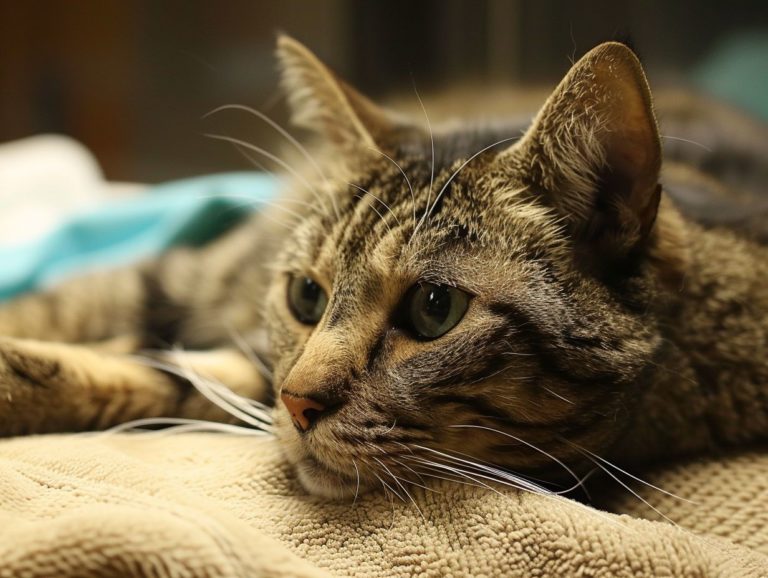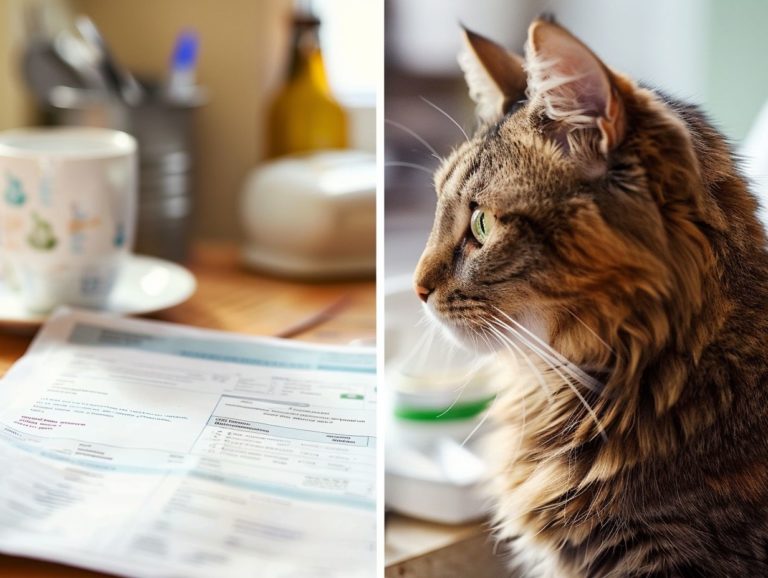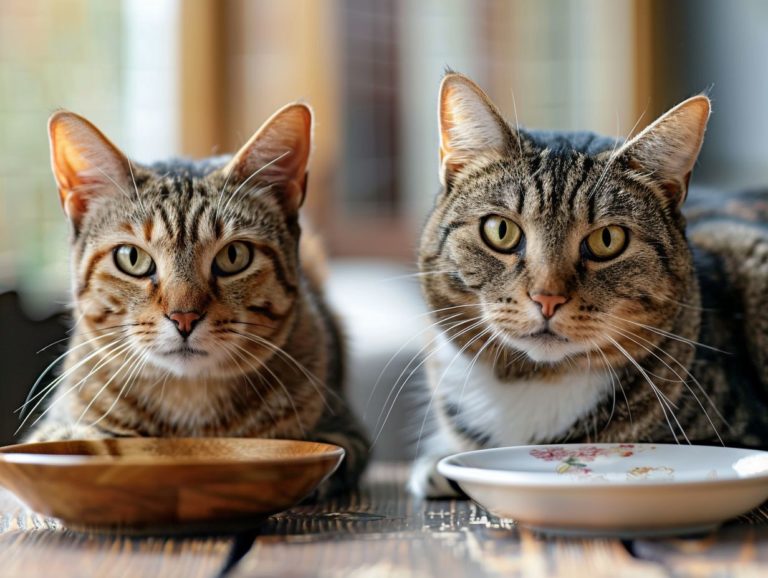From Kitten To Senior Transitioning Your Cats Insurance Coverage
This article explores the significance of adjusting cat insurance coverage as cats age, defines and emphasizes the importance of cat insurance, discusses the evolving needs of cats as they progress from kittenhood to adulthood and eventually to senior status, and underscores the importance of updating insurance policies to align with age-related requirements.
Additionally, it addresses the challenges associated with transitioning cat insurance coverage, outlines the necessary steps to transition cat insurance policies, and presents key factors to consider when selecting a senior cat’s insurance plan.
The primary objective of this article is to offer an educational resource that advocates for suitable insurance coverage for cats throughout all life stages.
Key Takeaways:
Understanding Cat Insurance
Understanding cat insurance is essential for responsible pet ownership. Cat insurance is a pet insurance policy that covers various health issues and medical expenses for a cat. Having cat insurance alleviates the financial burden of unexpected veterinarian bills, allowing the cat owner to provide optimal care without concerns about expenses.
Different policy options are available, such as accident-only plans, illness and accident plans, and comprehensive plans that include preventative care like vaccines and spaying, along with wellness exam coverage. Insurance providers support your cat’s health through services like 24/7 customer support, online claims processing, and a network of reputable veterinarians.
The cost of insurance, or premiums, is influenced by factors like the coverage amount and deductible you select. In general, having an insurance policy can lead to cost savings, particularly for costly and unforeseen medical bills.
What is Cat Insurance?
Cat insurance is a type of pet insurance that provides coverage for the cost of medical expenses and veterinary services for pet cats. It offers financial protection in the event of illness or injury for a cat. This coverage typically includes services such as annual check-ups, vaccinations, routine dental cleanings, and emergency treatment for accidents or sudden illnesses.
Cat insurance can also assist in covering the expenses of surgeries, medications, and diagnostic tests that veterinarians recommend to maintain a cat’s health and well-being. By having cat insurance, pet owners can mitigate unexpected costs and make well-informed medical decisions for their cat without the burden of financial worries.
Various insurance providers offer a range of plans with varying levels of coverage, deductibles, and premiums to cater to the diverse needs of cat owners.
Why Transitioning Coverage is Important
It is important to transition your cat’s coverage so that it evolves with their changing needs, ensuring they are consistently protected throughout all stages of their life. As your pet’s requirements evolve, their insurance coverage should also adapt accordingly. Upgrading your pet’s insurance policy or switching to a different provider can ensure that your pet receives necessary care without encountering high out-of-pocket expenses. Opting for a new policy may introduce coverage that was not included in their previous policy, such as coverage for senior cats or pets with pre-existing conditions. While changing plans may initially result in higher costs, the potential long-term savings and enhanced coverage for your pet make the transition worth considering.
Changes in Your Cat’s Needs
As cats age, their health requirements change, necessitating updates to their insurance to accurately reflect their health condition, potential risks, and associated costs. Older cats are more susceptible to health conditions such as arthritis, kidney disease, and dental issues, which may not have been significant concerns in their younger years.
Given these new risks, insurance plans may require modifications to encompass specialized treatments and medications. Regular visits to the veterinarian are essential to monitor your cat’s evolving health needs and ensure that insurance coverage is adjusted accordingly.
Proactive adjustments and staying informed provide optimal protection and care for your aging feline companion.
Benefits of Updating Coverage
Updating your cat’s insurance coverage by increasing coverage limits, adjusting premiums, and reducing waiting periods can be beneficial for senior pets. Updated insurance coverage helps in managing the costs of illnesses, reducing waiting periods, and ensuring comprehensive coverage for age-related conditions.
Keeping your senior cat’s insurance up-to-date ensures timely treatment when needed and improves their overall health outcomes. It enables pet owners to address age-related issues such as cat arthritis, diabetes, or kidney disease without financial concerns.
Updated coverage also minimizes treatment waiting times, ensuring prompt care for the pet. Proactive insurance management plays a vital role in enhancing the overall health and quality of life of senior cats.
Transitioning from Kitten to Adult
Changes in insurance coverage between kittens and adult cats are designed to address the increasing risks and needs that arise as cats age. As cats transition from kittens to adulthood, they become more vulnerable to various risks, such as the development of chronic illnesses, outdoor injuries, and age-related health issues that necessitate comprehensive coverage. Insurance plans tailored to their evolving requirements during this stage ensure that cat owners can offer optimal protection for their beloved pets in adulthood. This includes coverage for regular check-ups, vaccinations, dental care, and emergency medical treatments. These customized insurance plans provide assurance and financial stability in case of unexpected health crises.
Age-Related Coverage Changes
Changes in insurance coverage for cats based on age involve adjustments in policies to address age-related health issues, veterinary care needs, and increased financial expenses for older pets. Insurance coverage needs to evolve as cats progress through various life stages. Younger cats may benefit from insurance plans that focus on preventive care, vaccinations, and early detection of health issues to manage initial veterinary costs and establish a basis for long-term health.
As cats age, they may develop chronic conditions or require more advanced treatments, resulting in higher medical expenses. Modifying insurance policies to include coverage for managing chronic diseases, prescription medications, and potential emergency care is crucial for maintaining the well-being of older cats.
Transitioning from Adult to Senior
When transitioning from the adult to the senior life stage, it is essential to consider the cat’s health status, appropriate insurance coverage, anticipated medical needs, and associated costs for comprehensive care. As cats age, they develop specific age-related medical conditions such as arthritis, dental disease, kidney disease, and diabetes. Having insurance coverage that includes these conditions is crucial as it enables appropriate treatment and supportive care without imposing undue financial burden. Coverage tailored to address these age-related diseases in cats can significantly enhance the quality of life during the senior years.
Regular veterinary examinations, therapeutic diets, and medication management play a vital role in supporting the overall well-being of senior cats.
Common Health Concerns for Senior Cats
Senior cats are prone to health issues like arthritis, dental disease, kidney disease, and hyperthyroidism.
Insurance coverage can help minimize these risks and guarantee prompt medical intervention. Pet insurance plans designed for senior cats are structured to encompass a range of age-related ailments, ensuring that these animals receive necessary treatment without imposing a financial burden on their owners.
This coverage includes the capacity to afford regular check-ups, diagnostic tests, medications, and even potential surgeries for senior cats, aiding in maintaining a high quality of life during their later years.
The proactive nature of having insurance can also benefit senior cats by ensuring that pet owners promptly address any new medical conditions, leading to improved outcomes and a better quality of life for their aging feline companions.
Adjusting Coverage for Senior Cats
When adapting insurance coverage for senior cats, it is important to:
- Manage pre-existing conditions
- Formulate plans tailored to age-related conditions
- Provide appropriate comprehensive care for aging cats
Managing pre-existing conditions is crucial as insurers typically do not cover them. Insurance companies may request the pet’s medical history and a veterinarian may conduct a physical examination before insuring a senior cat. This step can impact the available insurance options and premium costs.
Formulating insurance plans specific to age-related conditions, such as arthritis, dental issues, or kidney disease commonly seen in senior cats, ensures appropriate care for these conditions.
Providing appropriate comprehensive care for aging cats involves regular veterinary check-ups to monitor for new conditions and adjust insurance coverage as needed to meet the senior cat’s requirements.
How to Transition Your Cat’s Insurance Coverage
When transitioning your cat’s insurance coverage, it is important to follow a systematic method to switch between plans, providers, and levels of coverage smoothly and without confusion. A step-by-step guide can assist in accomplishing this task.
- Begin by reviewing your current insurance policy to fully understand the coverage, limitations, and renewal dates.
- Conduct research on various insurance providers to compare their policies and find the one that best suits your cat’s needs at an affordable price.
- Once you have selected a provider, reach out to them to discuss the chosen plan and get a good idea of their requirements and policies.
- Be ready to provide details about your cat’s health history, including any pre-existing conditions.
- Discuss any modifications to the policy, such as changes in deductible amounts, coverage limits, and exclusions.
- Collaborate with the new insurance provider to effectively transfer your cat’s coverage and ensure there are no gaps in coverage.
Step-by-Step Guide
Transitioning your cat’s insurance coverage involves several steps, including:
- Evaluating your current plan
- Researching new insurers
- Comparing coverage options
- Switching to a new plan to ensure uninterrupted coverage
Start by reviewing the details of your current pet insurance plan for your cat, such as the level of coverage, premiums, deductibles, and any exclusion clauses. Next, research different insurance providers that offer coverage plans for cats, considering factors like reputation, customer reviews, and accreditation. Once you have identified potential new insurance plans for your cat, carefully compare the types of coverage, coverage limits, and additional benefits offered by each provider. With all the necessary information, proceed to transition your cat’s insurance coverage to the new provider by making the required changes, submitting paperwork, updating information, and ensuring a seamless transition to continue safeguarding your cat’s health and well-being.
Choosing the Right Insurance Plan for Your Cat
When identifying the best insurance for your cat, it is important to consider several key factors. These steps include evaluating coverage options, the reputation of the provider, cost-effectiveness, and the specific medical needs of your cat.
Coverage options vary among insurers and may include veterinary care, wellness checks, vaccinations, emergency visits, and coverage for pre-existing conditions. Assess the reputation of the provider by checking online reviews for customer satisfaction, processing time for claims, and responsiveness to inquiries.
In terms of cost-effectiveness, consider not only the monthly premium but also the deductible, co-pay, and any coverage limits in the policy. Lastly, ensure that the insurance is tailored to meet the specific medical needs of your cat.
Factors to Consider
When choosing a cat insurance plan, factors to consider include the age of your cat, any pre-existing conditions, the required level of coverage, and the services offered by the provider.
The age of your cat is a crucial factor because older cats may require more frequent vet visits and are more prone to age-related health issues. The age of your cat can impact the cost and availability of different senior cat insurance policies.
Pre-existing health conditions will significantly influence the available insurance options, as some plans may not cover these conditions. The severity and type of pre-existing condition can also impact the availability and cost of other plans.
Determining the appropriate level of coverage involves striking a balance between premiums and benefits, ensuring adequate coverage without overspending.
Assessing the range of services offered by different cat insurance companies can assist in selecting a plan that meets your pet’s specific needs and aligns with your budget constraints.
Frequently Asked Questions
What is the importance of transitioning my cat’s insurance coverage from kitten to senior?
As your cat ages, their healthcare needs and associated costs may change. Transitioning their insurance coverage ensures that they are adequately covered and you are prepared for any unexpected expenses.
When should I start thinking about transitioning my cat’s insurance coverage?
It is recommended to start thinking about transitioning your cat’s insurance coverage when they reach middle age, around 7 years old. This is when they may start developing age-related health issues.
Do insurance companies offer specific coverage for senior cats?
Yes, many insurance companies offer specific coverage for senior cats. This coverage may include routine care for age-related conditions, such as arthritis, dental care, and prescription medications.
Can I switch my cat’s insurance coverage at any time?
Yes, you can switch your cat’s insurance coverage at any time. However, it is important to note that pre-existing conditions may not be covered under a new insurance policy.
What factors should I consider when transitioning my cat’s insurance coverage?
When transitioning your cat’s insurance coverage, you should consider their age, health, and any pre-existing conditions. You should also review the coverage options and premiums offered by different insurance companies.
Is it possible to continue my cat’s insurance coverage into their senior years?
Yes, it is possible to continue your cat’s insurance coverage into their senior years. Many insurance companies offer lifetime coverage for cats, which means they will continue to be covered as they age.



